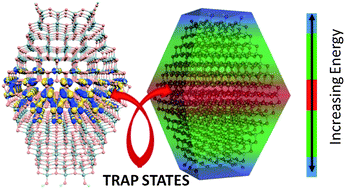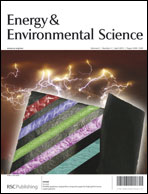Inherent electronic trap states in TiO2 nanocrystals: effect of saturation and sintering†
Abstract
We report a quantum mechanical investigation on the nature of electronic trap states in realistic models of individual and sintered anatase TiO2 nanocrystals (NCs) of ca. 3 nm diameter. We find unoccupied electronic states of lowest energy to be localized within the central part of the NCs, and to originate from under-coordinated surface Ti atoms lying mainly at the edges between the (100) and (101) facets. These localized states are found at about 0.3–0.4 eV below the fully delocalized conduction band states, in good agreement with both electrochemical and spectro-electrochemical results. The overall Density-Of-States (DOS) below the conduction band (CB) can be accurately fitted to an exponential distribution of states, in agreement with capacitance data. Water molecules adsorbed on the NC surface raise the energy and reduce the number of localized states, thus modifying the DOS. As a possible origin of additional trap states, we further investigated the oriented attachment of two TiO2 NCs at various possible interfaces. For the considered models, we found only minor differences between the DOS of two interacting NCs and those of the individual constituent NCs. Our results point at the presence of inherent trap states even in perfectly stoichiometric and crystalline TiO2 NCs due to the unavoidable presence of under-coordinated surface Ti(IV) ions at the (100) facets.


 Please wait while we load your content...
Please wait while we load your content...